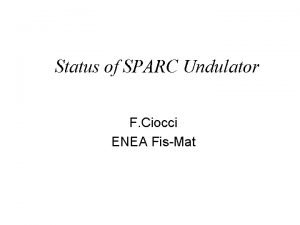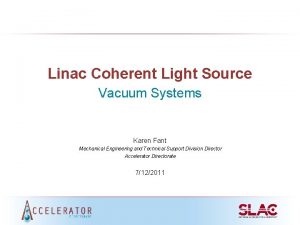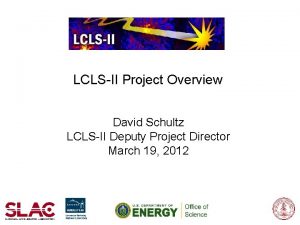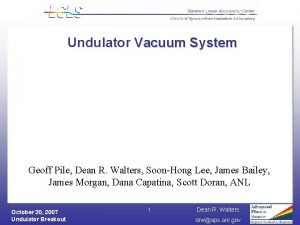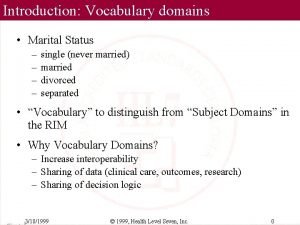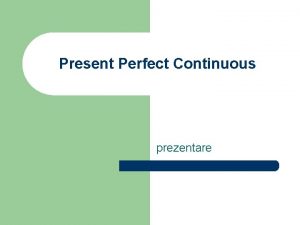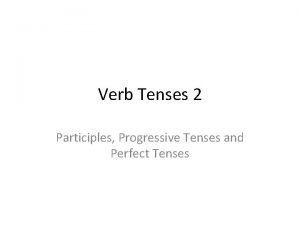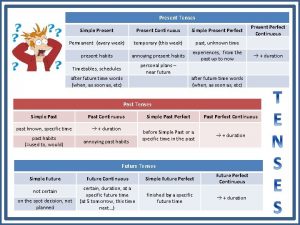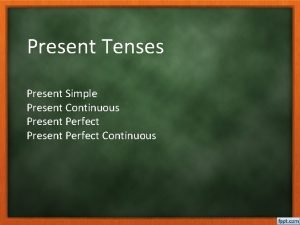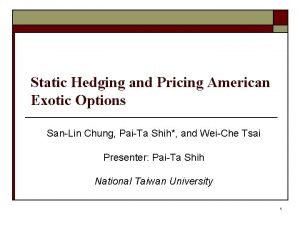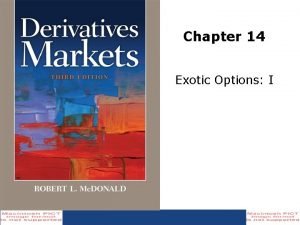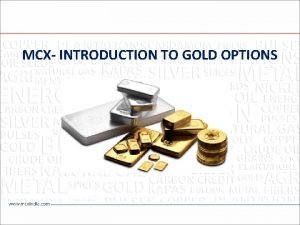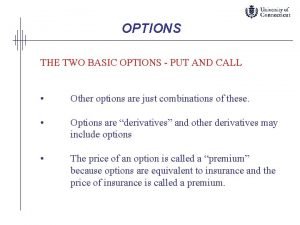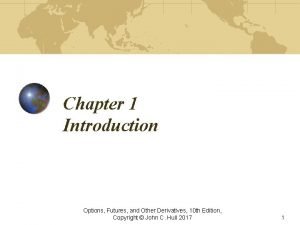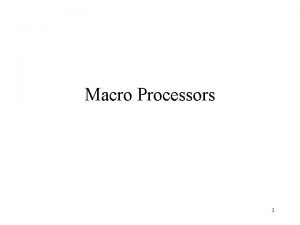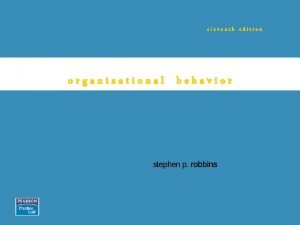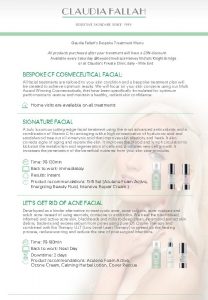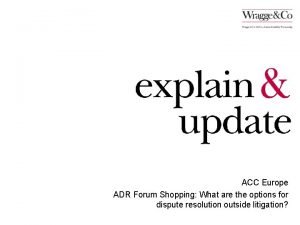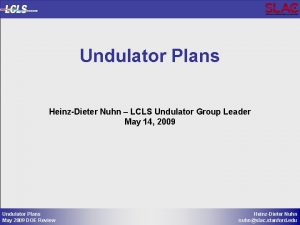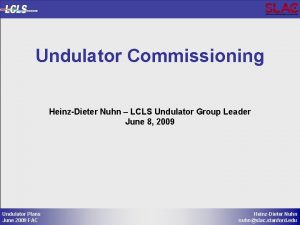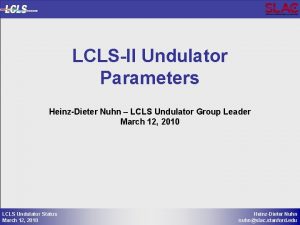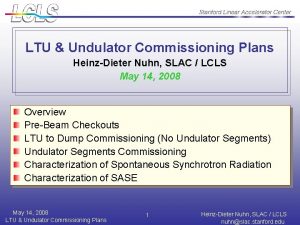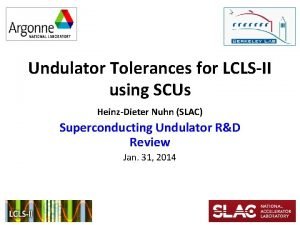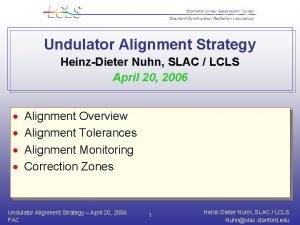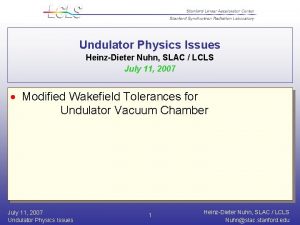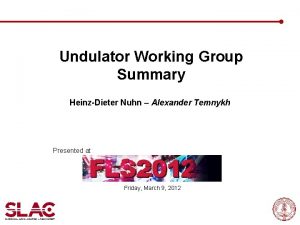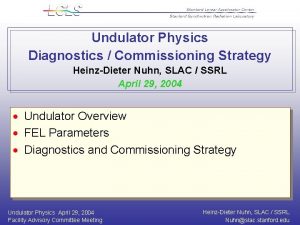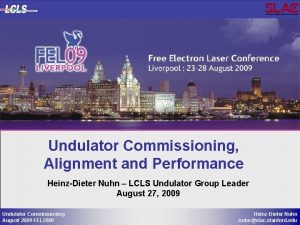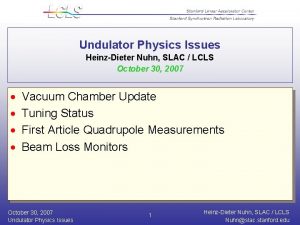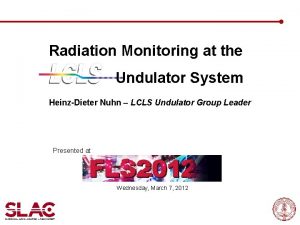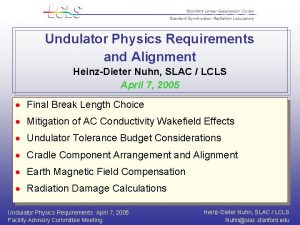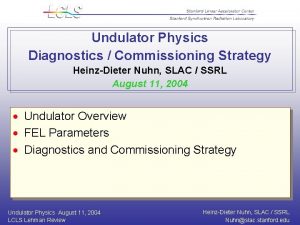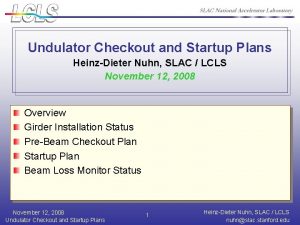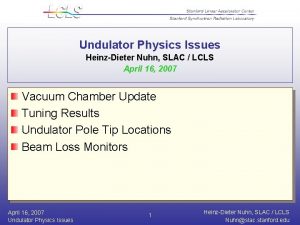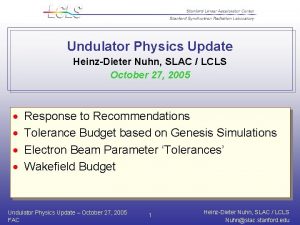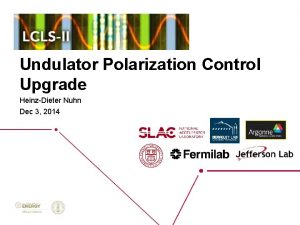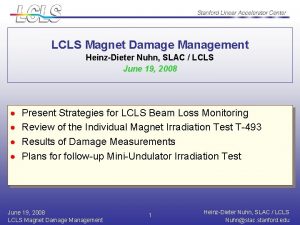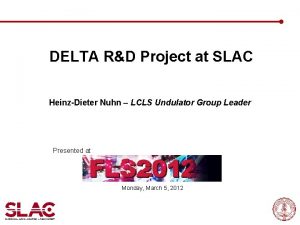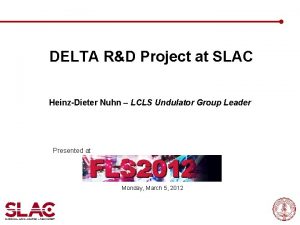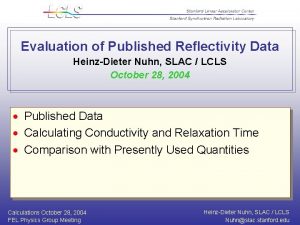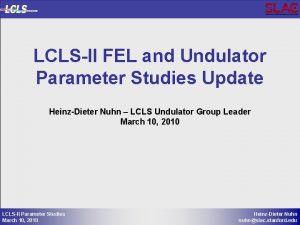LCLSIISC Undulator Options Present Status 08242013 HeinzDieter Nuhn



![Assumed Beam Parameters NLS NGLS LCLS-IISC Beam energy [Ge. V] 2. 25 2. 4 Assumed Beam Parameters NLS NGLS LCLS-IISC Beam energy [Ge. V] 2. 25 2. 4](https://slidetodoc.com/presentation_image_h2/991e12c9e259a7c90c84ab8088aab67b/image-4.jpg)

























- Slides: 29

LCLS-IISC Undulator Options Present Status 08/24/2013 Heinz-Dieter Nuhn, Tor Raubenheimer, Juhao Wu

Outline 1. Assumed beam parameters and undulator requirements 2. Baseline undulator parameters 3. LCLS performance with HXR 4. Short gain length options for SXR 5. SCU options and benefits 6. Genesis simulations Caveats: not all simulation/calculations are done for exactly the same period devices and parameters but they are similar and can be scaled to understand parameter the space Insert Presentation Title in Slide Master 2

Assumed FEL Configuration • High rep rate beam could be directed to either of two undulators HXR or SXR bunch-by-bunch • 120 Hz beam could be directed to the HXR at separate times • The SC linac would be located in Sectors 0 -10 and would be transported to BSY in the 2 km long Bypass Line. It would use a dual stage bunch compressor. • A dechirper might be used to further cancel energy spread for greater flexibility in beam parameters • The high rep rate beam energy would be 4 Ge. V and the HXR would fill the LCLS hall with ~144 m while the SXR would be <75 m so that it could be fit into ESA • Both undulators would need to support self-seeding as well as other seeding upgrades Insert Presentation Title in Slide Master 3
![Assumed Beam Parameters NLS NGLS LCLSIISC Beam energy Ge V 2 25 2 4 Assumed Beam Parameters NLS NGLS LCLS-IISC Beam energy [Ge. V] 2. 25 2. 4](https://slidetodoc.com/presentation_image_h2/991e12c9e259a7c90c84ab8088aab67b/image-4.jpg)
Assumed Beam Parameters NLS NGLS LCLS-IISC Beam energy [Ge. V] 2. 25 2. 4 4 Bunch charge [p. C] 200 300 100 Emittance [mm-mrad] 0. 3 0. 6 0. 43 Energy spread [ke. V] 150 ke. V 300 ke. V Peak current [k. A] 0. 97 0. 5 1 Useful bunch fraction [%] 40 50 50 The assumed emittance of 0. 43 at 100 p. C is roughly 25% larger than the LCLS-II baseline. It is more conservative than the NLS or the scaled NGLS values (the latter are consistent with the LCLS-II baseline) however a gun has not yet been demonstrated that achieves the desired emittances. Reduced emittances will decrease gain lengths. Peak current is consistent with higher energy beams and BC’s Insert Presentation Title in Slide Master 4

High Level Parameters from David Schultz Table Preliminary machine parameters Line v 0. 4 8/21/2013 SXR HXR Repetition rate 100 k. Hz 120 Hz Electron Energy 4 Ge. V 4 Gev 14 Gev Electron Energy spread 300 ke. V 1000 ke. V Transverse slice emittance 0. 4 μm 0. 3 μm Peak current 1 k. A 3 k. A Pulse charge 100 p. C 20 -200 p. C 0. 2 -1. 3 ke. V 1. 3 -5 ke. V 0. 25 -20 ke. V Photon pulse energy 200 μJ <10 m. J Photon beam power < 30 W < 50 W < 0. 01 W Photon beam power (DF) 20 W 1. 2 W Photon energy Insert Presentation Title in Slide Master @ 100 p. C limit 5

Undulator Requirements: 1. SXR self-seeding operation between 0. 2 and 1. 3 ke. V in ESA tunnel (<75 meters) with 2. 5 to 4 Ge. V beam 2. HXR self-seeding operation between 1. 3 and 4 ke. V in LCLS tunnel (~144 meters) with 4 Ge. V beam 3. HXR SASE operation up to 5 ke. V with 4 Ge. V beam 4. Primary operation of SXR and TXR at constant beam energy large K variation 5. HXR operation comparable to present LCLS with 2 to 15 Ge. V beam Insert Presentation Title in Slide Master 6

Undulator Parameters 1. To cover the range of 0. 2 to 1. 3 ke. V using SASE in less than 50 meters (to allow for seeding) lw ~ 40 mm • A conventional hybrid undulator with 40 mm and a 7. 2 mm minimum gap would have Kmax ~ 6. 0 which easily covers the desired wavelength range at 4 Ge. V 2. To achieve 5 ke. V using SASE with less than 144 meters at 4 Ge. V TXR lw <= 26 mm • • A conventional hybrid undulator with 26 mm and a 7. 2 mm minimum gap would have Kmax ~ 2. 4 which covers desired wavelength range at 4 Ge. V Provides reasonable performance with LCLS beam Insert Presentation Title in Slide Master 7

Baseline Tuning Range for 4 Ge. V HXR: lw = 26 mm, L = 144 m Kmin = 0. 55 SXR: lw = 41 mm, L = 75 m SASE Self-Seeding Ephoton [ke. V] Kmin = 0. 91 Kmin = 1. 6 Self-Seeding Kmax = 2. 44 Kmax = 6. 0 Ebeam [Ge. V] Kmin is chosen to saturate within given length for SASE or Self-seeding K is set to the maximum value for a 7. 2 mm gap variable gap undulator

X-ray pulse energy at High Rate More than enough FEL power although results assume full beam and are ~2 x optimistic Insert Presentation Title in Slide Master 9

Comparison of HXR with LCLS performance at 120 Hz (1) 26 mm HXR covers 2 ke. V at ~4 Ge. V to 30+ ke. V at 14 Ge. V – beam energy might be reduced futher if desired Insert Presentation Title in Slide Master 10

Comparison of HXR with LCLS performance at 120 Hz (2) 26 mm HXR provides lower pulse energy than 30 mm LCLS Insert Presentation Title in Slide Master 11

Options for HXR: SCU, IV, or 30 mm period (1) To recover the LCLS performance, we need to increase K. Can (1) increase the period, (2) adopt an in-vacuum design, or (3) consider a planar or helical SCU. Example of a helical SCU below however have not incuded poorer SCU fill factor results are optimistic Insert Presentation Title in Slide Master 12

Options for HXR: SCU, IV, or 30 mm period (2) Example of a 30 mm period hybrid undulator below. Nearly recovers LCLS performance (reduction due to slightly larger gap with VG undulator) however the maximum photon energy at high rate, i. e, 4 Ge. V is now 4. 3 ke. V not 5 ke. V as with 26 mm period Insert Presentation Title in Slide Master 13

Short Gain Length Options for SXR The full length of 75 m will be tight in ESA at the maximum photon energy of 1. 3 ke. V and provides little margin. There are three options: (1) lower the beam emittance through either a better injector (LCLS comparable – see slide 4), (2) decrease the SXR period and increase K, or (3) decrease the beam energy and the SXR period. Example 1: decrease to 26 mm with K=2. 4 gain length roughly ½ but almost all tuning is done with energy Example 2: decrease to 30 mm with K=2. 0 self-seeding at 1. 6 ke. V and 4 Ge. V requires ~65 meters Problem: a shorter period conventional hybrid SXR will not cover the full wavelength range at constant energy SCU Insert Presentation Title in Slide Master 14

SCU options An SCU has a number of benefits: 1. Would attain comparable performance as LCLS even while achieving 5 ke. V at 4 Ge. V at high rate by operating with high K 2. Would reduce allow shorter SXR period to reduce SXR beam energy and gain length to ensure space in ESA while still covering full wavelength range at constant energy. Insert Presentation Title in Slide Master 15

GENESIS SIMULATION ELECTRON PARAMETERS Centroid energy 4 Ge. V; 100 p. C compressed to 1 k. A; normailized emittance: 0. 45 mrad; slice energy spread: s. E = 300 ke. V except for LCLS case with 15 Ge. V 6 cases – details in following pages Good Case 1: HXR Kmin = 0. 91; lw = 26 mm; Lw = 144 m (study SS 4 ke. V) Bad Case 2: SXR Kmin = 1. 6; lw = 41 mm; Lw = 75 m (study 1. 6 ke. V) Good Case 3: SXR Kmax = 6. 0; lw = 41 mm; Lw = 75 m (study 200 e. V) Barely Case 4: SXR K = 1. 9; lw = 41 mm; Lw = 75 m (study 1. 3 ke. V) Case 5: SXR K = 2. 0; lw = 30 mm; Lw = 75 m (short gain len. ) Good OK Case 6: HXR in LCLS TW parameters but K too high for hybrid undulator J. Wu (SLAC), jhwu@slac. stanford. edu, 08/05/2013 16

Summary Present parameters based on: HXR: 26 mm, 144 meters hybrid VG SXR: ~40 mm, 75 meters hybrid VG (simulations for 41 and 39 mm – either work). Both choices have limitations: SXR gain length is too long to guarentee self-seeded operation at 1. 6 ke. V in ESA (barely works at 1. 3 ke. V) HXR does not reproduce LCLS performance Shorter period SXR and longer period HXR fix some issues but introduce others. SCU solves many limitations. Insert Presentation Title in Slide Master 17

CASE 1: HXR SHORTEST SEEDING WAVELENGTH Case 2: HXR Kmin = 0. 91; lw = 26 mm; Lw = 144 m SASE: saturates around 70 m J. Wu (SLAC), jhwu@slac. stanford. edu, 08/05/2013 18

CASE 1: SELF-SEEDING OK AT 4 KEV Case 1: HXR Kmin = 0. 91; lw = 26 mm; Lw = 144 m Self-seeding: will saturates Monochromator J. Wu (SLAC), jhwu@slac. stanford. edu, 08/05/2013 19

CASE 2: SXR 1. 6 KEV Case 2: SXR Kmin = 1. 6; lw = 41 mm; Lw = 75 m SASE: saturates around 60 m J. Wu (SLAC), jhwu@slac. stanford. edu, 08/05/2013 20

CASE 2: SXR SELF-SEEDING NOT OK AT 1. 6 KEV Case 2: SXR Kmin = 1. 6; lw = 41 mm; Lw = 75 m Self-seeding: won’t saturates Monochromator J. Wu (SLAC), jhwu@slac. stanford. edu, 08/05/2013 21

CASE 3: SXR AT 200 EV – SHORT GAIN LENGTH Case 3: SXR Kmax = 6. 0; lw = 41 mm; Lw = 75 m SASE: saturates around 35 m J. Wu (SLAC), jhwu@slac. stanford. edu, 08/05/2013 22

CASE 3: 200 EV SELF-SEEDING FINE Case 3: SXR Kmax = 6. 0; lw = 41 mm; Lw = 75 m Self-seeding: will saturates Monochromator J. Wu (SLAC), jhwu@slac. stanford. edu, 08/05/2013 23

CASE 4: SXR AT 1. 3 KEV Case 5: SXR Kmin = 1. 9; lw = 41 mm; Lw = 75 m SASE: saturates around 55 m J. Wu (SLAC), jhwu@slac. stanford. edu, 08/05/2013 24

CASE 4: SXR AT 1. 3 KEV BARELY OK FOR SELF-SEEDING Case 5: SXR Kmin = 1. 9; lw = 41 mm; Lw = 75 m Self-seeding: barely saturates Monochromator J. Wu (SLAC), jhwu@slac. stanford. edu, 08/05/2013 25

CASE 5: ALTERNATE SXR FOR SHORTER GAIN LENGTH Case 4: SXR Kmax = 2. 0; lw = 30 mm; Lw = 75 m SASE: saturates around 45 m J. Wu (SLAC), jhwu@slac. stanford. edu, 08/05/2013 26

CASE 5: ALTERNATE SXR FOR SHORTER GAIN LENGTH Case 4: SXR Kmax = 2. 0; lw = 30 mm; Lw = 75 m Self-seeding: will saturates Monochromator J. Wu (SLAC), jhwu@slac. stanford. edu, 08/05/2013 27

CASE 6: HXR WITH 15 GEV BEAM – K NOT REALISTIC Case 1: HXR K = 4. 2; lw = 26 mm; Lw = 144 m SASE: saturates around 50 m Centroid energy 15 Ge. V; 150 p. C compressed to 3 k. A; normailized emittance: 0. 4 mrad; slice energy spread: s. E = 1. 3 Me. V J. Wu (SLAC), jhwu@slac. stanford. edu, 08/05/2013 28

CASE 6: HXR AT 15 GEV BUT K NOT REALISTIC Case 1: HXR K = 4. 2; lw = 26 mm; Lw = 144 m Self-seeding: reaching about 500 GW Monochromator J. Wu (SLAC), jhwu@slac. stanford. edu, 08/05/2013 29
 Undulator
Undulator Undulator
Undulator Undulator
Undulator Chain clamp
Chain clamp Maritial status
Maritial status Outlook 365
Outlook 365 Present perfect continuous schema
Present perfect continuous schema Present simple present continuous and present perfect
Present simple present continuous and present perfect Relative clause noredink
Relative clause noredink Present perfect present simple present continuous
Present perfect present simple present continuous Do and does use
Do and does use Present perfect conjugation
Present perfect conjugation Present simple present continuous present perfect
Present simple present continuous present perfect Sarva shiksha abhiyan punjab
Sarva shiksha abhiyan punjab How did the guidance movement develop in the philippines
How did the guidance movement develop in the philippines Multidomestic company
Multidomestic company Management chapter 5 planning and decision making
Management chapter 5 planning and decision making Static hedging of exotic options
Static hedging of exotic options Knock in knock out option
Knock in knock out option Opwdd housing options
Opwdd housing options Gold guinea lot size
Gold guinea lot size Az benefit options
Az benefit options Option trading
Option trading Engagement options
Engagement options Options, futures, and other derivatives
Options, futures, and other derivatives Macro processors are
Macro processors are Customer responsive culture examples
Customer responsive culture examples Fortify sca installation guide
Fortify sca installation guide Fallahs
Fallahs Forum adr
Forum adr
